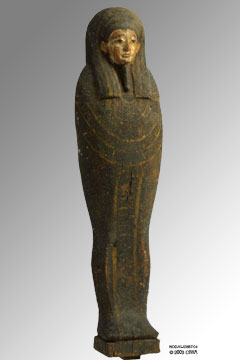Large wooden Ka statue, Dyn. 26

Links to other views:⇒ Larger Viewif scripting is off, click the ⇒ instead. Links to others from Dynasty 26Amulet of Pataikos, Dyn. 26Amulet of Shu, Dyn. 26 Bronze of a king as Osiris, Dyn. 26 Bronze of a king as Osiris, Dyn. 26 Bronze of King Psamtik I as Osiris, Dyn. 26 Bronze of King Psamtik I as Osiris, Dyn. 26 Bronze statuette of Bastet, Dyn. 26 Cartouche of King Nekau II, Dyn. 26 Djed pillar, amulet of powers, Dyn. 26 Face from a sarcophagus lid, Dyn. 26 Face from a sarcophagus lid, Dyn. 26 Faience shawabti of Hekamsaf, Dyn. 26 Falcon sarcophagus with Osiris mummy Glass necklace terminal, Dyn. 26 Horus-the-Child, heir to the king, Dyn. 26 King Ahmose II (?) as Osiris, Dynasty 26 King Nekaw II as Horus-the-child, Dyn.26 Light blue faience shawabti, Dyn. 26 Osiris with Djed pillar on back, Dyn. 26 Sarcophagus and mummy of Taosir, Dyn. 26 Shawabti of Admiral Hekaemsaf, Dyn. 26 Shawabti of Hor, son of Rurer, Dyn. 26 Shawabti of Hor-sa-Iset-Mut-f, Dyn. 26 Shawabti of Hor-Wdja, Dyn. 26 Shawabti of Khonsu-Hor, Dyn. 26 Shawabti of King Psamtik I, Dyn. 26 Shawabti of King Psamtik I, Dyn. 26 Shawabti of King Psamtik II, Dyn. 26 Shawabti of King Psamtik II, Dyn. 26 Shawabti of King Psamtik III, Dyn. 26 Shawabti of Mery-Seth-Hor-Mes, Dyn. 26 Shawabti of Mery-Seth-Hor-Mes, Dyn. 26 Shawabti of Neith-M-Hat, Dyn. 26 Shawabti of Prince Horiraa, Dyn. 26 Shawabti of Prince Horiraa, Dyn. 26 Shawabti of Prince Horiraa, Dyn. 26 Shawabti of Prince Ir-Irw, Dyn. 26 Shawabti of Prophet Wahibre, Dyn. 26 Shawabti of Prophet Wahibre, Dyn. 26 Shawabti of Psamtik-mry-imn, Dyn. 26 Shawabti of Psamtikmeryptah, Dyn. 26 Shawabti of Royal Prince Ahmes, Dyn. 26 Staff finial, Thoth as a baboon, Dyn. 26 Two-fingers mummy amulet, Dyn. 26 Udjat eye amulet-pendant, Dyn. 26 Udjat eye amulet-pendant, Dyn. 26 Udjat eye amulet-pendant, Dyn. 26 Upper Egypt crown amulet, Dyn. 26 Wooden sarcophagus lid, circa 650 BC Wooden sarcophagus lid, Dyn. 26 Links to others of type KaKa statue of King Amenemhet III, Dyn. 12 |
This large wooden statue represents the Ka of a privileged man. The face is gilded, with the eyes and brows deftly outlined in black. The defunct wears the ritual Osirian beard, and a large wig. The falcon god Horus appears on each shoulder. An oversized beaded collar is painted on his torso and abdomen, beneath which a vertical register holds ritual hieroglyphic inscriptions meant to accompany the defunct in his voyage. Another register of hieroglyphs runs down the back from the bottom of the wig to the feet. The general style is indicative of Saite Dynasty 26 (664-525 BC). Khalil (Khalil 1976:[2]123-127) transcribed and translated the texts as follows: on the front, one reads (with much difficulty) “The Lord concerning of you ‘thee’ Osiris who always causes to go to ...” (ntr hr k Osiris ddi pr n ...). On the back one reads: “It was said by Osiris the Lord of the West, the great-god, the master of Abydos, he may give invocation for offering to the KA of. . .” (dd mdw in wsir hnty imntyw ca ntr nb abdw di s f prt-hrw n ka. . . This item was once part of Vicomtesse Dalton’s collection. Dynasty 26 Born in times of weakness, when Egypt was regularly invaded and generally controlled by the Assyrians, Dynasty 26 (‘the Saite Dynasty’) was installed at the head of the tiny kingdoms of Sais and Athribis in the Delta by the Assyrian king Ashurbanipal. This turned out to be a bad move for Assyria. Within 12 years, in an astonishing reversal of fortunes, the Saite king Psamtik would reunify Egypt under his crown and liberate his nation from Assyrian domination. Weaving the clear threat of his military power with extremely agile diplomacy and carefully orchestrated ideology, Psamtek brought about the political reorganization that had eluded his predecessors for four hundred years. At last, Egypt was once again led by a centralized authority—an all powerful king, a guardian of order, a living god. It was a true rebirth for Egypt, with a once again thriving economy, a recovered sense of national identity, and a new-found opening to the outside world—most particularly to the Greek World. Under Psamtik’s agile leadership, Egypt was simultaneously moving forward and drawing strength from its glorious past—most particularly that of the Old and Middle Kingdoms. This was particularly manifest in the arts. Craftsmen of the Saite period aspired to equal, and hoped to surpass, their Middle Kingdom predecessors, while adhering closely to the classic canons of aesthetic tradition—a scenario that would play out again 2200 years later when artists of the Italian renaissance sought to rise to the standards set by their Ancient Greek predecessors. Managing their new prosperity with great skill, while keeping the Babylonians at bay, the Saites embarked on an ambitious program of building, restoring, and embellishing. Commerce flourished under dedicated military protection and ambitious public works projects, such as the digging of a canal from the Nile to the the Red Sea—2500 years before the Suez Canal. Although brilliant by its achievements and the remarkable period of peace and stability it carved within the context of an increasingly turbulent Mediterranean world, the Saite Dynasty was somewhat short-lived (139 years). Its increasing reliance on foreign mercenaries caused tensions, and eventually infighting within the military establishment. Militarily weakened, Egypt became easy prey for the Persian juggernaut. In 525, Persia took over Egypt, putting a sudden end to the Saite period. Egypt would never again shine so brightly. Bibliography (for this item)Khalil, Hassan M.1976 Preliminary Studies on the Sanusret Collection. Manuscript, Musée l’Egypte et le Monde Antique, Monaco-Ville, Monaco. ([2]123-127) |